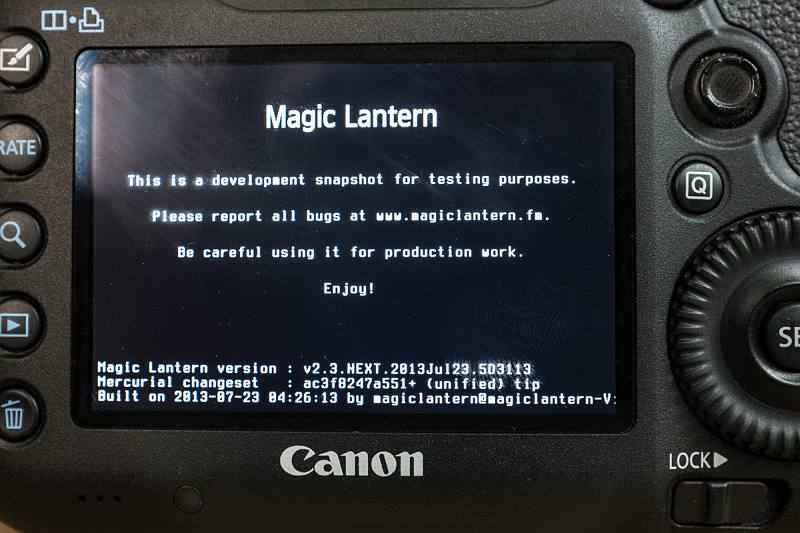

- #Magic lantern canon mark iii full#
- #Magic lantern canon mark iii software#
- #Magic lantern canon mark iii zip#
I use zip ties and extra lead weights to accomplish this. It makes for a large system but the stability it provides is very good.įor underwater time-lapses or macro images, you need to stabilize the setup on the sea floor with extra weight. I’ve extended the rear leg towards me as I shoot, bracing against my chest for a third anchor point. On occasion I have used a Gates tripod mounted via the screw on the base of the housing for wide-angle work in mid water. Wide arms for your video lights increase the inertia of the rig and dampen the wobble. Float arms, whether they are the hollow carbon tube variety or the sealed foam type, work well-and they also serve as stabilizers. Secondly, you need a setup that is as close to neutrally buoyant at depth as possible.

The first step to compensate for this is having the ability to dive smoothly and to keep your composition, even in challenging conditions. However, this smaller form factor translates to less inertia, and thus less stability when shooting. The small form factor of the 5D Mark III is ideal for tight traveling restrictions and ease-of-use underwater. Shooting at a frame rate of 24 frames per second minimizes the risk of missing frames and allows for the use of advanced features like focus peakingĥD Mark III Setup for Underwater Videography At this frame size, however, the camera will start to max out and using focus peaking at the same time might lead to dropped frames-so tread carefully. At this frame rate, the camera isn’t running at maximum and it is less likely that it will fail or miss frames.Īt this slightly reduced frame rate, screen overlay can also be used for focus peaking, even when increasing the frame size to 1920x1290. However, there is very little wiggle room at that level and I choose instead to back it off a little and shoot at 24 fps. The camera is capable of filming RAW at 29.97 fps in 1920x1080. Magic Lantern enables a whole host of abilities not standard on the 5D Mark III, but I use it mainly for time-lapse and RAW video. Magic Lantern Underwater Video Camera Settings For running the firmware, I use the Lexar 16GB Class 10 SD card and do not write anything else to it other than Magic Lantern.
#Magic lantern canon mark iii full#
These will still fill up quite quickly, so have a few available for a full day of shooting.

I use the Lexar 128GB UDMA 7 1066x CF for media acquisition. You need memory cards that will be able to keep up with this output and processor speed. The processor is working extremely hard and the output is high, at about 100MB/s. When recording RAW with Magic Lantern, you are running the camera at about 95 percent capacity. Possibly one of the biggest make-or-break components are memory cards.
#Magic lantern canon mark iii software#
In this highlight reel, you can see the professional capabilities inherited by combining the Canon 5D Mark III and Magic Lantern software Some of the tips that follow are specific to the 5D Mark III, but some are applicable to any Canon DSLR running on Magic Lantern. In the process of researching the system and using it for over two years, I’ve found certain things that may possibly help other underwater shooters. Producers have sought stock shots with it and it gets used a lot in high-end productions. Fortunately, the camera did not instantly turn into an expensive paperweight, and I’ve used it on a large number of professional projects and gigs without any problems. It was a daunting prospect-taking a $3,500 camera and immediately invalidating the warranty. Note that although completely safe to use with a spectrum of Canon DSLRs, it does void the warranty that accompanies the camera. Magic Lantern is a third-party firmware that adds a host of upgrades to your DSLR, most notably the ability to shoot in 14-bit RAW. So after a lot of research I decided to go for the 5D Mark III specifically to use the Magic Lantern firmware. One of the main advantages of shooting in RAW with Magic Lantern is the ability to fine-tune color correction, highlights, shadows and more That might suffice for some but that’s not what many-myself included-are satisfied with.

Yes, a GoPro or any other camera that can be put in a housing will produce decent video with the built-in H.264 codec, but it is often monochromatic with the highlights blown out and flat colors. However, it just doesn’t have the flexibility to stand up to the demands of high quality underwater filming and color correction. Now standard with many DSLRs like the 5D Mark III, H.264 is a reasonable codec in well lit and relatively low dynamic range environments. The 5D Mark III and Magic Lantern for Underwater Videography Combining the Canon 5D Mark III with Magic Lantern firmware takes the camera’s abilities to a whole new level. However, as always, there is room for improvement. Eight years ago, the Canon EOS 5D Mark II revolutionized DSLR video, and its successor, the 5D Mark III remains one of the best DSLRs for professional footage.


 0 kommentar(er)
0 kommentar(er)
